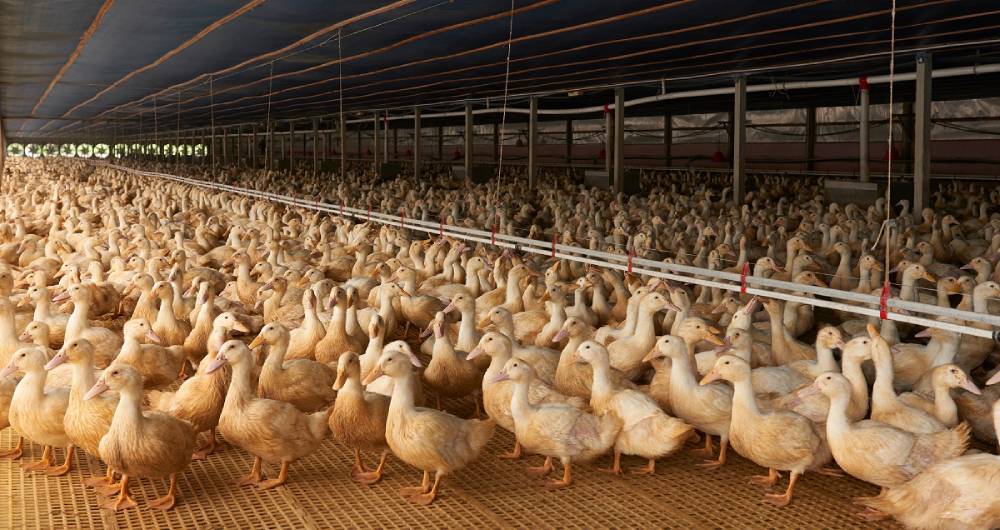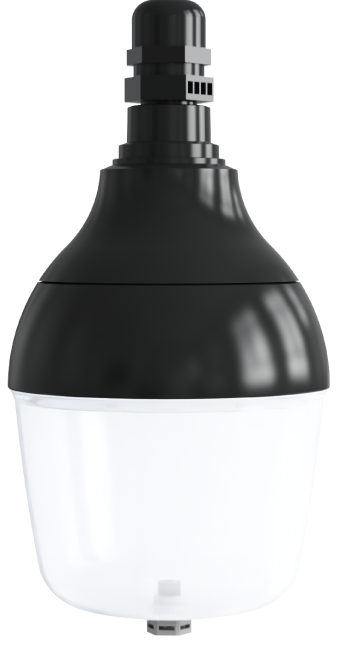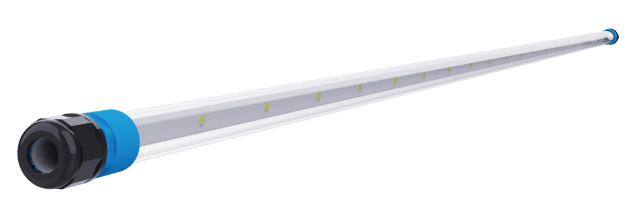Waterfowl Lighting Design and Management
Waterfowl Lighting Design and Management

Directory:
1. The influence of light on waterfowl
2. Waterfowl Lighting Design
3. Waterfowl Lighting Management
1. The influence of light on waterfowl
Light plays a significant role in the feeding, activity, growth, and reproduction of waterfowl, particularly in regulating their sexual maturity. Both light and nutrition are crucial for their development. Young birds, in particular, need extended periods of light exposure to support their feeding and rapid growth. While natural light is essential, artificial lighting is also necessary. During the rearing phase, waterfowl typically rely on natural light to avoid premature sexual maturity. However, during the egg-laying phase, a light schedule of 15 to 16 hours per day helps stimulate gonadal development, follicle maturation, ovulation, and enhances egg production.
2. Waterfowl Lighting Design
Waterfowl housing incorporates both natural and artificial lighting. Natural lighting allows sunlight and diffused light to enter through windows, doors, and other openings, while artificial lighting involves the use of light bulbs. The design of poultry houses primarily focuses on artificial lighting. Depending on the width of the house, 2 to 3 rows of light bulbs are installed inside, positioned about 1.7 to 2.2 meters above the ground. Typically, 3 to 5W bulbs per square meter are sufficient for lighting needs. Additionally, a 25W bulb is placed in the center or on one side of the house for dim lighting at night after the main lights are turned off.
3. Waterfowl Lighting Management
3.1 Geese Lighting Management
3.1.1 Feeding management during the brooding phase
Goslings, which are young geese from hatching to 30 days old, have low resistance to stress, limited adaptability, and tend to cluster together. Effective waterfowl lighting management is crucial for enhancing the production performance and survival rates of goslings. During the brooding phase, it is important to maintain longer lighting periods to help goslings acclimate to their environment, increase their activity levels, and encourage them to eat and drink, thus fulfilling their nutritional requirements for growth. For the first 1-3 days, continuous light is provided, then reduced by one hour every two days, transitioning to natural light by four weeks of age. Light intensity guidelines include using one 40W bulb for every 15m² for goslings aged 0-7 days, and switching to a 25W bulb for ages 8-14 days, positioned about 2 meters above the back of the geese.
3.1.2 Feeding and Management of Growing Geese
Growing geese, also referred to as young or middle geese, are those aged between 30 to 60 days. There are three methods for feeding these geese: grazing, a combination of grazing and house feeding, and solely house feeding. Typically, growing geese are raised using natural light.
3.1.3 Feeding and Management During the Fattening Period
Once the geese reach around 60 days of age, those selected for breeding are kept according to specific standards, while the remaining geese are moved to a commercial goose house for fattening. This fattening phase usually lasts between 15 to 20 days. There are three common methods for fattening: in-house, in pens, and forced fattening. The geese that are fattened become plump and tender, offering a high slaughter yield, a significant amount of edible parts, and considerable economic value. During this period, geese are provided with continuous low-intensity light (1 to 2 lx), which is sufficient for management purposes. Excessively bright light can hinder their growth and development, while dimmer lighting helps keep the geese calm, reduces their activity levels, lowers energy expenditure, and promotes quicker weight gain and fattening.
3.1.4 Breeding Geese Lighting Management
Breeding geese are those selected for reproduction, including both males and females. They go through a reserve period and an egg-laying period. The reserve period spans from 70 to 80 days old until they begin laying eggs. The goal during this time is to enhance their breeding value and prepare them for mating or egg production. Management of reserve breeding geese is typically done in stages. In the early (80 to 100 days old) and middle stages (100 to 150 days old), natural light is utilized, while artificial light is gradually increased in the later stage (from 150 days old until laying begins). It takes about six weeks to adjust the lighting duration (combining natural and artificial light) to reach 15 hours of light during the egg-laying phase. This 15-hour lighting schedule continues consistently until the end of the laying period.
3.2 Duck Lighting Management
3.2.1 Laying Ducks Lighting Management
3.2.1.1 Ducklings Lighting Management
Ducklings particularly require sunlight, which helps raise their body temperature and enhances blood circulation. Ultraviolet rays in sunlight convert 7-dehydrocholesterol found in their skin, feathers, and blood into vitamin D3. which supports bone development, boosts appetite, stimulates digestion, and aids metabolism. When natural light is unavailable or insufficient, artificial lighting can be used as a supplement.
During the brooding phase, the light intensity can be higher and the duration slightly longer. In the first week, the first three days post-hatching should have continuous light for 24 hours to help ducklings acclimate to their surroundings, with a typical light intensity of around 10 lux. After four days, the light can be on for 20-23 hours daily. In the second week, the lighting duration can be reduced to 18 hours. From the third week onward, adjustments should be made based on specific conditions. For summer brooding, natural light should be utilized during the day, with dim lighting at night, and brighter lights only for 30 minutes during feeding. In late autumn, due to shorter daylight, the evening lighting can be extended by 1-2 hours, while still using dim lights throughout the night.
3.2.1.2 Growing Ducks Lighting Management
During the growth phase, young ducks do not require intense lighting. A consistent lighting duration of 8 to 10 hours per day is recommended, and it should not be increased before they begin laying eggs. For ducks raised in the latter half of the year, natural light is most beneficial. However, to ensure ducks can drink water at night and to deter pests like mice or birds, the duck house should have low-level lighting throughout the night. A 15W bulb is sufficient for a 30m² duck house. In case of a power outage, kerosene lamps with glass covers or other lighting sources should be activated immediately. Ducks exposed to low light for extended periods may become extremely startled in sudden darkness, leading to significant losses.
Lighting plan for raising ducks during the rearing phase:
If the introduction of this group of ducks occurs between late August and early April of the following year, the lighting strategy for the rearing phase should utilize either the decreasing lighting method or the constant lighting method.
Gradually decreasing lighting method: Step 1: Determine the date when this group of ducklings reaches 20 weeks old, for example, February 20 of the following year; Step 2: Identify the natural daylight duration around February 20 in your area, such as 11.2 hours; Step 3: Create a suitable lighting schedule. For the first 0-8 weeks, follow the brooding lighting guidelines. If the lighting is set to 20 hours at 8 weeks, then from the 9th week onward, reduce the light duration by 45 minutes each week (or turn off the lights 45 minutes earlier), so that by the 20th week, the lighting duration is exactly 11 hours, aligning closely with natural daylight. If the light intensity is 23 hours at 8 weeks, then from the 9th week, decrease the light duration by 1 hour each week (or turn off the lights 1 hour earlier), resulting in a lighting duration of 11 hours by the 20th week, which is also close to natural light levels.
Constant light method: If the date when this group of ducklings reaches 20 weeks is February 20 of the following year, and the natural light duration is 11.2 hours, round it to 12 hours. Starting from the 9th week, maintain a daily light duration of 12 hours (combining natural and artificial light), with lights on from 6 am to 6 pm.
Light management during the egg-laying period: Most egg-laying duck breeds begin laying eggs at around 150 days of age and peak at 200 days. Proper lighting can stimulate laying ducks, enhancing the growth and development of follicles through the combined effects of the nervous system and endocrine system, thus promoting egg production.
During the laying phase, natural light is supplemented with artificial lighting. To ensure consistent high production, laying ducks require a stable lighting system. An effective lighting schedule for laying ducks starts at around 150 days old, gradually increasing light exposure by 20 minutes each day until reaching 16 to 17 hours of light, with an intensity of 5 lux. The light source should be positioned 2 meters above the ground, providing 1.4 watts per square meter of the duck house, or using a 25-watt bulb for every 18 square meters. Once established, the lighting should remain at 16 hours daily without reduction. If egg production falls to 60%, the lighting duration can be extended. It is important to avoid sudden changes in lighting or reducing the duration, as this can lead to stress and deformities in eggs. In case of frequent power outages, have kerosene lamps or alternative lighting ready. Light bulbs should be evenly spaced, arranged in a cross pattern, and cleaned regularly. When activating lights at night, only dim lighting is necessary. Additionally, the lighting system should be integrated with feeding and management practices to maximize its effectiveness.
3.2.2 Meat Ducks Lighting Management
3.2.2.1 For meat ducks, commercial ducklings should receive continuous lighting for the first 7 days, followed by 18 hours of light daily from 7 to 14 days, and then 12 hours of light per day until they are ready for slaughter. However, the light intensity should be moderate. During the day, natural light should be utilized, with low-intensity lighting in the morning and evening sufficient for feeding visibility. The light intensity should be 5 watts per square meter, with bulbs positioned 2 to 2.5 meters above the ground.
3.2.2.2 In terms of feeding and management for broiler ducks, the brooding period, which lasts from 0 to 4 weeks of age, involves specific management practices for the ducklings during this stage.
Lighting management during the rearing phase: From 5 to 20 weeks of age, the lighting principle emphasizes shorter durations and lower intensity to avoid early sexual maturity. Typically, lighting is set for 9-10 hours daily, primarily utilizing natural light. If the rearing period coincides with a season of increasing daylight, the lighting duration should be maintained within the limits established at 19 weeks, with artificial light added as needed, but not exceeding a total of 11 hours. Conversely, if natural light decreases, natural lighting should be used, gradually increasing to 17 hours by 26 weeks, starting at 4 am and ending at 9 pm, with darkness for the remainder of the time. For instance, if natural light at 20 weeks is 8 hours, an additional 9 hours of artificial light is required to achieve the 17-hour target. This 9 hours is distributed evenly over 6 weeks, adding 1.5 hours each week starting from 21 weeks.
Lighting management during the egg-laying phase: Provide 17 hours of light daily, with a light intensity of 2W per square meter, lamps positioned 2 meters high, and shades covering the lamps. Ensure even light distribution, maintain a consistent schedule, and avoid changes, as this could negatively impact egg production rates.
4. Related Products



5. Contact Ceramiclite
_thumb.jpg)
